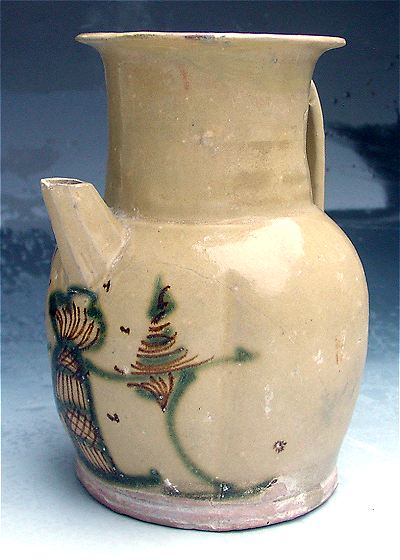
An important kiln area situated in South China during Tang Dynasty. Also called Tongguan Kiln due to its discovery in today's Wazhaping, Tongguan Town, Changsha City in Hunan Province.
Changsha was active by the end of the Tang Dynasty (618-907), peaked from late Tang to Five Dynasties, and declined after Five Dynasties. Its main product were wares with a grayish-green glaze, but all iron based earth colors occurs.
All kinds of ceramic products were made, including molded figures, as well as thrown utilarian pots, jars and dishes of all shapes and decorations. A well known typical shape is a short-spouted ewer with a globular body and a straight neck.
The kilns is noted for its rich and varied decoration of all kinds, especially its early painted decoration of figures, natural ornaments and calligraphy, as well as applied ornaments or dipped, painted and splashed glazes. Potters working near Changsha in southern China seem to have been the first to experiment with and perfect underglaze decor which was one of the most influential Tang ceramic achievements, which was also to have a long lasting importance. By painting their designs directly onto the clay body or slip coat and then covering them with a clear glaze before firing, potters could protect their designs in a way not previously possible. The colors used in the underglaze designs varied from brown and green hues and sometimes but rarely a blue underglaze color seems to have been used.
In the 9th century, when these techniques began to be used with blue underglaze, the practice spread worldwide. The types and decorations seems to have been developed in contact with the world markets, and in particular through a large community of over 100,000 Arabs who are known to have been living and working in Canton, Guangzhou province during the Tang Dynasty, engaged in sea trade with Arabia.
In 1997 fishermen just north of the port of Tanjung Pandan on the Indonesian island of Belitung, (between Sumatra and Borneo) discovered a ship wreck of a Ninth Century Dhow. From their fishing nets they recovered a number of distinctly colored bowls and ewers which could be easily identified as originating from the Changsha kilns of Hunan province in China. Changsha pottery was only produced during the later years of the Tang Dynasty (AD 618-906). This allowed archeologists to get a close fix on the date that the ship might have sailed. The ship contained many other goods, including star anise (Illicium anisatum), a distinctly Chinese export.
Tang ceramics have been found in south-east Asia, the Indian subcontinent, Sri Lanka, the Indus Valley, the Persian Gulf, around the Red Sea, and as far inland as Samarra, the Abbasid capital, and as far west as old Cairo in Egypt, and Antioch on the Syrian coast, and as far south as the Comoros Island and Zanzibar. The quantities of Tang ceramics found in India are very small. It also seems like the earliest Chinese ceramics to be found in southern India dates to the eleventh century AD why the archaeological evidence then points to the Belitung ship as traveling to Arabia. (Flecker:2001:348).
Illustration: Mid 9th century Changsha Ewer with underglaze decoration in green and brown on a white slip covering a dark melon shaped body, under a clear fine-meshed crackled glaze. Height 18,5 cm / 9.75 inches. J-E Nilsson Collection, 2003.
A